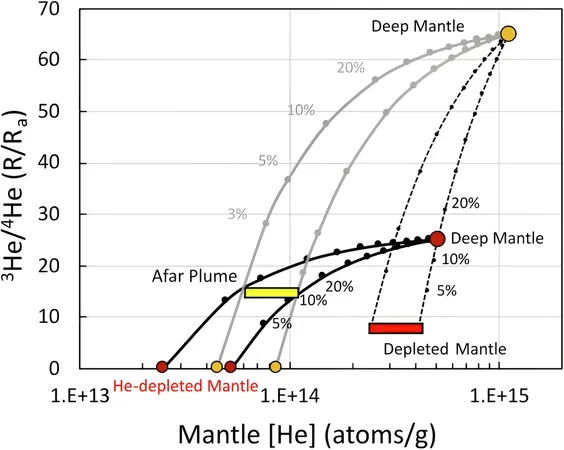
Groundbreaking Study of Afar Mantle Plume Reshapes Our Understanding of Earth's Interior!
2024-09-25
Introduction
An exciting new study has emerged from an international collaboration led by researchers from the Scottish Universities Environmental Research Center (SUERC) and the University of Glasgow. The team has provided unprecedented insights into the structure and behavior of mantle plumes—large, hot columns of rock that rise from deep within the Earth, previously thought to consist primarily of primordial materials.
Challenging Long-Held Assumptions
Traditionally, scientists have believed that these mantle plumes transport ancient material from the Earth's core and mantle to the surface, forming the basis for volcanic activity. However, a sophisticated analysis of volcanic rocks from the Afar region, particularly those erupted along the Red Sea, has unveiled startling revelations that challenge this long-held assumption.
Innovative Research Techniques
Using state-of-the-art mass spectrometry, researchers examined tiny bubbles of ancient gas trapped in basaltic glass from lava flows. Their findings reveal that these volcanic rocks contain significantly lower concentrations of primordial helium than previously expected—up to ten times less! This suggests that the materials making up the Afar mantle plume primarily stem from surface rock that has been recycled back into the Earth through subduction rather than from the deep mantle.
Impact of Findings
Ugur Balci, a postgraduate researcher and the lead author of the study published in *Communications Earth & Environment*, emphasized the implications of this work, stating, "Our results indicate that the Afar plume is largely composed of rock that was at the Earth's surface less than 100 million years ago. This fundamentally alters our understanding of how such mantle plumes are generated."
Seismic Tomography and Subduction Zones
To further explore this phenomenon, the researchers employed seismic tomography—a method similar to medical MRI—to create detailed models of the subsurface. This technique allows scientists to visualize the distribution and movement of subducted ocean floor materials, revealing interactions between the Afar plume and younger, subducted material located around 660 km beneath the surface.
Contributions from Research Team
Dr. Antoniette Greta Grima, co-author of the study, noted, "The isotopic analysis combined with seismic modeling paints a clearer picture of the dynamic processes at play in the Earth's interior. By linking ancient subduction zones beneath the Zagros Mountains to our findings, we can better understand the complex geological history of this region."
Conclusion
This research not only advances scientific knowledge but raises critical questions about our foundational understanding of tectonic processes. Professor Fin Stuart of SUERC, who led the project, remarked, "This study challenges the prevailing notion that all mantle plumes carry material exclusively from deep Earth. Our ability to merge isotope geochemistry with geodynamic modeling has produced groundbreaking insights."
As the scientific community continues to analyze the data and explore the implications of these findings, one thing is clear: our understanding of the forces shaping the Earth’s surface is undergoing a profound transformation. For anyone intrigued by geology and Earth's mysteries, this study opens exciting new avenues for exploration that could redefine our grasp of deep Earth processes!



 Brasil (PT)
Brasil (PT)
 Canada (EN)
Canada (EN)
 Chile (ES)
Chile (ES)
 España (ES)
España (ES)
 France (FR)
France (FR)
 Hong Kong (EN)
Hong Kong (EN)
 Italia (IT)
Italia (IT)
 日本 (JA)
日本 (JA)
 Magyarország (HU)
Magyarország (HU)
 Norge (NO)
Norge (NO)
 Polska (PL)
Polska (PL)
 Schweiz (DE)
Schweiz (DE)
 Singapore (EN)
Singapore (EN)
 Sverige (SV)
Sverige (SV)
 Suomi (FI)
Suomi (FI)
 Türkiye (TR)
Türkiye (TR)